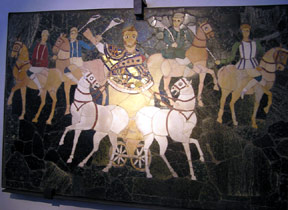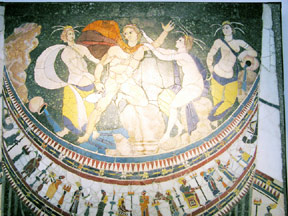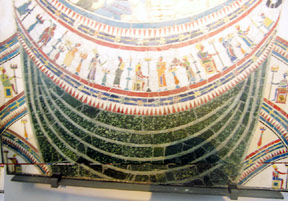Καλλιτεχνικά έργα με πλακάκια Κροκεάτη Λίθου Απο την εκκλησία το Ιουνίου Βάσσου 359μ.Χ. Αρχαιολογικό Μουσείο Palazzo Massimo Ρώμη, Ιταλία Φωτογραφίες: Settimio Cecconi |
Krokeatis Lithos Opus sectile frescoes with Lapis Lacedaemonius From the Basilica of Iunius Bassus- 359A.D. Archaeological Museum of Palazzo Massimo Rome, Italy Pictures by: Settimio Cecconi |
Κάνετε κλικ στα εικονίδια για να μεγαλώσουν Click on pictures to enlarge |
|
The consul Iunius Bassus among circus factions in marble marquetry, 331-350 A.D. (Rome: Basilica of Iunius Bassus). The senatorial aristocracy's power, resting on their vaste rural estates, enabled them to address local problems, but coopted central authority. In the new Constantinian political order, this local power tended to isolate and marginalize the aristocracy, and so they tried to build solidarity by developing a cultivated correspondence that bordered on conspiracy by recalling the days of senatorial independence, and they rallied behind their natural political leader, one or another consul. Indeed, the consul imitated the emperor's hieratic mediating function for the army and officialdom, by representing himself as mediator for the senatorial aristocracy. Associated with this was a blossoming of private (non-monumental) art forms. The ceremonial high point of a consul's career was to initiate the games, and here Iunius Bassus actually participates. Many hieratic features are here: the frontal stiffness, reduction of plastic values to flat pattern, centralized composition, expressive facial features, gesture and color. from:http://www.hp.uab.edu/image_archive/ulf/ulfa.html |
|
| |
Hylas and Nymphs
|
Opus Sectile (Καλλιτεχνική εργασία με πλακάκια) αναφέρεται σε μια τεχνική που αναπτύχθηκε επί Ρωμαϊκής εποχής, όπου έσχιζαν τα υλικά σε λεπτά πλακάκια και τα γυάλιζαν, τα έκοβαν ανάλογα με το σχέδιο και τα τοποθετούνταν σε τοίχους και πατώματα για να κάνουν μια εικόνα ή ένα σχέδιο. Τα συνηθισμένα υλικά ήταν τα μάρμαρα, μαργαριτάρια και το γυαλί. Αντίθετα από την τεχνική των μωσαϊκών, όπου τα ομοιόμορφα-ταξινομημένα κομμάτια τοποθετούνται κατά τέτοιο τρόπο ώστε να διαμορφώνουν ένα σχέδιο, τα πλακάκια ( Τεμάχια opus sectile ) είναι πολύ μεγαλύτερα και μπορούν να αποτελέσουν ένα μεγάλο μέρος του σχεδίου. |
Opus sectile refers to an art technique popularized in Rome where materials were cut and inlaid into walls and floors to make a picture or pattern. Common materials were marble , mother of pearl , and glass . The materials were cut to thin places, polished, and then cut further according to the design. Unlike mosaic techniques, where the placement uniformly-sized pieces forms a design, opus sectile pieces are much larger and can form large parts of the design. |
|
|


